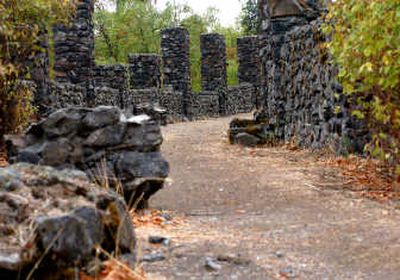Landmarks: Reader ruminates over ruins

From the Reader’s Mailbag: “I have always wondered what the remains are that are across from Office Depot on Third and Arthur. It overlooks I-90. It looks like it may have been a house at some point. There are still steps.” – Julie Shepard
No, not a house. It’s called the Ruins, and the site is actually the portion of Liberty Park that remained when I-90 was extended through the east central section of the city in 1967 – right through the park.
When the city sold 18 of the park’s 21 acres for freeway construction in the 1960s, the city purchased 12 acres for a new Liberty Park located safely on the south side of I-90. The bisected remainder – on the freeway’s north side, visible from I-90’s westbound lanes by the Arthur Street overpass – was once home to a swimming pond, walking paths, a play area, curved pergola, octagonal shelters and a pond used for wintertime ice skating. The basalt remains, which Julie Shepard sees from the Third and Arthur intersection, are echoes of the original structures, such as stairways, rock walls and vertical columns that once supported roofs of the shelters.
A lot has been written about this site, especially since the original Liberty Park was one of the parks designed by the famous Olmstead Brothers, who were responsible for Spokane’s first comprehensive park plan 100 years ago, and for whom a centennial commemoration is now being held. As part of the Olmstead celebration, the Museum of Arts and Culture in Browne’s Addition opened an exhibit, Olmstead Brothers: Designing Spokane Landscapes, on Oct. 6; it runs through next Aug. 17 ( www.northwestmuseum.org).
Carolyn Jacobs of the East Central Neighborhood Steering Committee/Council, which is spearheading a restoration campaign for the Ruins, said she believes it is the only Olmstead-designed park that has fallen into disrepair.
Back in 1997, it was an overgrown jungle of vegetation and debris and was a well-used hobo camp. Since then, the East Central group has partnered with Spokane Preservation Advocates and organized numerous work parties to clear debris and vegetation from the site to make it accessible for the public again.
Except for the haul-away, clearing and cleaning has been done by volunteers – some coming from far away, including a church group from Vancouver, Wash., who took it on as a community service project – and Geiger Correctional Facility work crews. City Parks crews removed more than 50 cubic yards of debris from the site.
In 2006, the East Central group sought Spokane Register of Historic Places designation for Historic Liberty Park. Money has been allocated from a Community Development Block Grant to install gravel pathways, park benches and handrails. Future development plans call for flower beds, excavating, construction of a parking lot and a barrier along I-90.
The Ruins, located on a bluff overlooking the freeway, will never be the quiet, genteel park of days gone by. But Jacobs and others who value the city’s fine parks and their history are hoping the Ruins can be preserved as ruins have been elsewhere.
Back in 1997, they were termed Spokane’s Stonehenge. Good role model, Jacobs suggests.